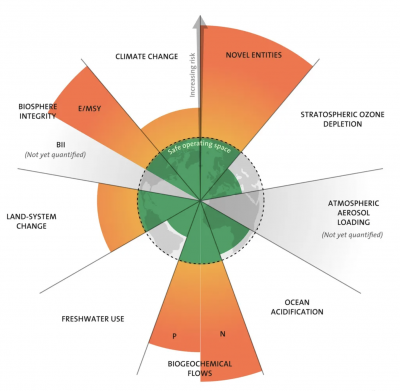Ecological crisis
In the 1960s, humans took about three-quarters of what the planet could regenerate annually.[1] By 2016 this rose to 170 percent. We are now amidst, a great race between how fast we can get to a social tipping point versus the time it takes to reach a global ecological tipping point. Of the 9 recognised planetary boundaries (Figure 1) we have already transgressed five:
- Climate change - since records began in 1880, nineteen of the twenty hottest years have occurred since 2000[2].
- Biodiversity loss - there has been a 68% average decline in the population sizes of mammals, birds, amphibians, reptiles, and fish between 1970 and 2016[3].
- Nitrogen cycle - ammonia factories supplement the enzymatic magic of microbial nitrogen fixation with the brute forces of temperature and pressure, extracting close to 100 million metric tons of nitrogen from the atmosphere each year. This results in the creation of Nitrous Oxide which is a 200 times more potent as a greenhouse gas than CO2[4].
- Deforestation - more than half the world’s tropical forests have been destroyed since the 1960s[5].
- Ocean acidification - more CO2 in the atmosphere means more acidity in the oceans.
- Microplastics via overconsumption - humanity is running an ecological Ponzi scheme in which society robs nature and future generations to pay for boosting incomes in the short term.[6]
- Ozone depletion, the phosphorus cycle...

Root Cause
In the study of medicine, when a symptom develops, a bad doctor will only treat the symptoms. A good doctor will treat the symptoms whilst looking for the root cause. We are currently concentrating on most pressing symptom, climate change, our remedy is divesting from fossil fuels and investing in renewables however this distracts from the other growing symptoms and reduces the collective alarm to persist and address the root cause.
It's easy to say its capitalism, the pursuit of profit, however perhaps it is ignorance of hidden externalities.
References
- ↑ 1.0 1.1 Underestimating the Challenges of Avoiding a Ghastly Future, Front. Conserv. Sci. Published on 13 January 2021, accessed on 19 June 2022 via: https://doi.org/10.3389/fcosc.2020.615419
- ↑ NASA, Global Temperature, live data source can be obtained via: https://climate.nasa.gov/vital-signs/global-temperature/
- ↑ IPBES, Media Release, Nature’s Dangerous Decline ‘Unprecedented’; Species Extinction Rates ‘Accelerating’ May 2019. https://ipbes.net/news/Media-Release-Global-Assessment
- ↑ Effects of Nitrogen Fertilizer Types on Nitrous Oxide Emissions. Martin Burger and Rodney T. Venterea Understanding Greenhouse Gas Emissions from Agricultural Management. January 1, 2011 , 179-202 DOI:10.1021/bk-2011-1072.ch011
- ↑ International Union for Conservation of Nature. (2021, February). Deforestation and forest degradation. https://www.iucn.org/resources/issues-briefs/deforestation-and-forest-degradation
- ↑ Yale Environment 360: Avoiding a ‘Ghastly Future’: Hard Truths on the State of the Planet. Accessed on 3rd March 2022 via:https://e360.yale.edu/features/avoiding-a-ghastly-future-hard-truths-on-the-state-of-the-planet